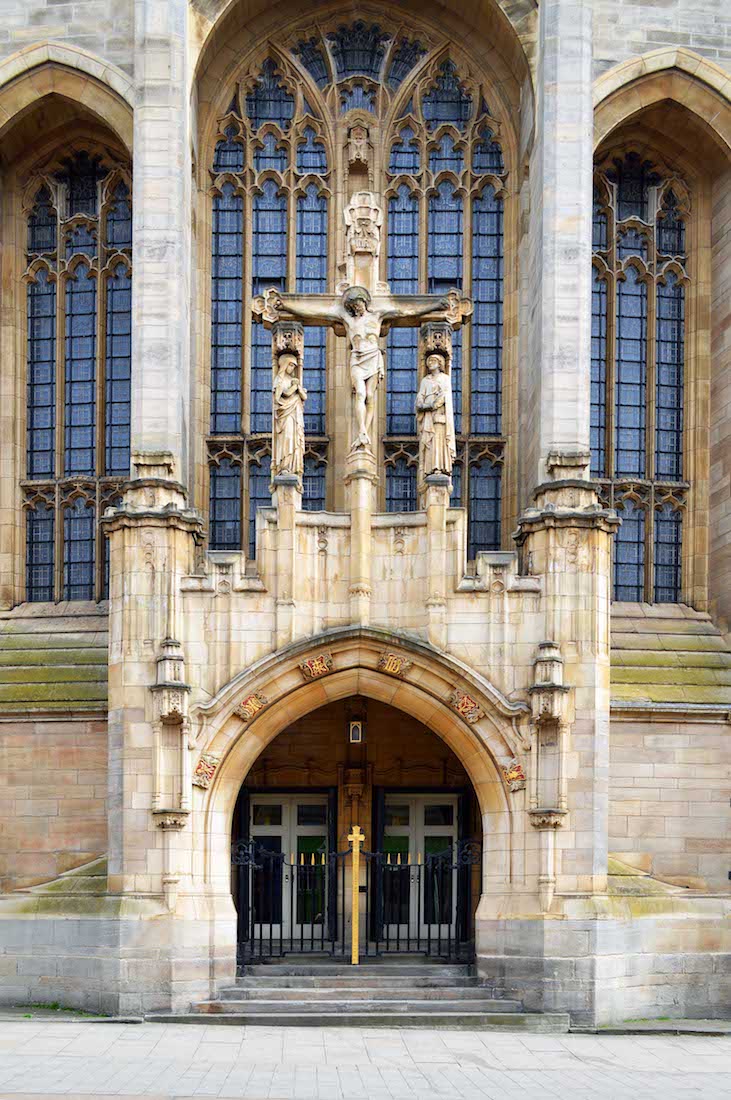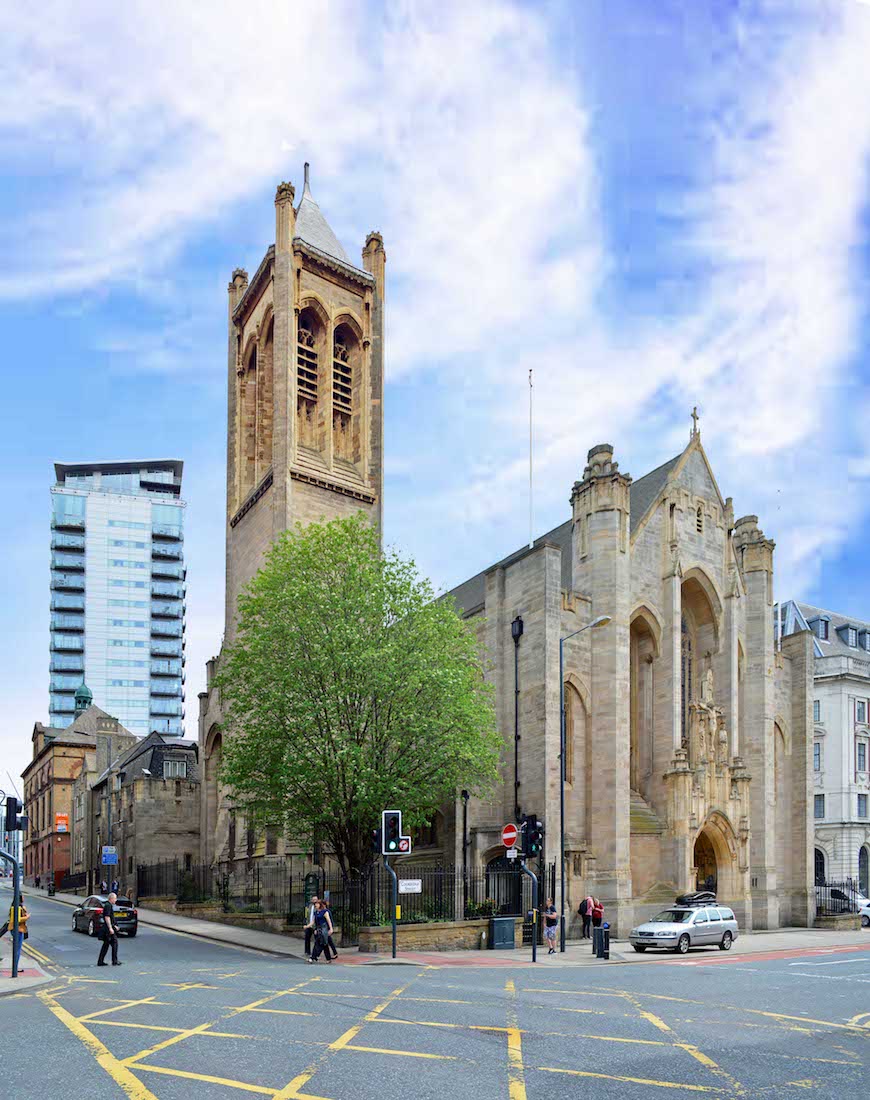
From the city centre, we approach the Catholic Cathedral of St Anne up Cookridge Street. It is a fine looking building of cream coloured stone blocks. The story of St Anne’s Cathedral begins in 1786 when a Dominican priest, Fr. Albert Underhill, moved the long established Roundhay Mission to premises in the centre of Leeds. Some rooms were obtained in a building off Briggate to house the mission, and the town’s first Catholic place of worship since the Reformation came into existence. PLAN
2. SOUTHWEST VIEW

Moving closer, we look along little St Anne’s St towards the South transept and chapter house.
3. SOUTH WALL AND TRANSEPT
Walking up St Anne St a little way, we get a closer view of the transept and chapter house. This current building opened in 1904. The name St Anne is in honour of Anne Humble, the late sister of Grace and Sarah Humble, the principal benefactors of the first church. Of course St Anne is also traditionally recognised as the mother of St Mary.
4. CHAPTER HOUSE
A small chapter house stands near this corner of the Cathedral. On my visit the door to the chapter house was locked, preventing public access. Perhaps there is good reason for this!
5. WEST WALL
Returning to Cookridge St, we stand directly in front of the imposing West wall of the Cathedral. Construction of the present Cathedral began in 1901 and was completed in the early part of 1904.
6. WEST DOOR
This is an impressive West doorway, with decorative carvings along the archway, and essentially a rood cross above, with the crucified Christ at centre, and SS Mary and John standing on either side.
7. NORTHWEST VIEW
We are now standing at the intersection of Cookridge St with Great George St. We have a good view of the tower. The new Cathedral had a single bell which did service until 1980 when the ring of eight were transferred from the redundant, and now demolished, church of St Francis of Assisi in Holbeck. The single bell was transferred to St Robert’s Roman Catholic Church in Harrogate.
8. WEST TRANSEPT, TOWER
From Great George St we see that the North transept abuts the tower. Later we shall find that a War Memorial Chapel is located in the base of the tower. This neo-Gothic style Cathedral has an unusual layout to accommodate the Cathedral’s relatively small city centre site.
9. NOTICE BOARD
We are unable to circumnavigate the Cathedral, at least closely, because of other buildings. So we return to the intersection of George and Cookridge Streets. Here we find a Cathedral notice board indicating a busy schedule of services throughout the week. Also of interest here is the coat of arms for the Leeds Diocese. The blue outer shield with fleurs-de-lys has reference to the Virgin Mary, the green inner shield has the Yorkshire rose.
10. TO THE CATHEDRAL
The grand West entrance opening onto busy Cookridge St appears not to be used during the week. However there are doors on either side of the West nave, and we shall enter through the North door. There is a pleasant little patch of greenery here.
11. NAVE
The Leeds Cathedral website makes the claim that, ‘Leeds Cathedral is one of the finest Catholic Cathedrals in England’. I can think of some competitors here, but this is certainly a very fine cathedral. The nave is short and wide, in order to make the most of the site. I am interested that the arches, while pointed in the Gothic style, are here somewhat flattened.
12. NAVE CEILING
The attractive nave ceiling, and the smaller sanctuary ceiling, continue the flattened Gothic theme of the arches, and completely hide the roof supports. The pattern of (green) wooden boards and parallel joists shows through faintly.
13. NAVE LOOKING WEST
We stand in the central nave aisle and look to the West. The West windows are of clear glass, and the baptismal font stands in the aisle near the West doors. Six (in fact) stations of the cross are displayed across this wall, and two icons above the doors. Illuminated alcoves hold a shrine to St Anne, and a display of the holy oils. On either side, near the columns, a statue stands.
14. BAPTISMAL FONT
The baptismal font is located in the centre aisle near the West doors. This traditional placing reinforces the idea of the rite of baptism being an introduction into the Church and the Christian life. The top part of the font is supported by angelic beings and has various Christian symbols on its eight sides. A circle of text on the floor reads: ‘The living waters flow from the right side of the Temple to the east. Along the river grows every kind of fruit with leaves that never wither and fruit that never fades.’
15. WEST WALL STATIONS OF THE CROSS
The stations of the cross are a series of fourteen pictures or carvings representing successive incidents during Jesus’ progress from his condemnation by Pilate to his crucifixion and burial. Across this West wall are Stations X – VII. In reverse order these are: V Simon of Cyrene helps Jesus to carry his cross; VI Veronica wipes the face of Jesus; VII Jesus falls the second time; VIII Jesus meets the women of Jerusalem; IX Jesus falls a third time; X Jesus clothes are taken away.
16. ICONS
Above the West door are these icons of St Peter and St Paul. Identification is easy here, because the names are included (in Greek!). Traditionally St Peter is identified by the Keys of the Kingdom which he holds, St Paul by his preaching with scroll or book in his hand, and often also holding a sword.
17. THE WEST ALCOVES
In the left (South) alcove we see St Anne teaching the young Mary to read. St Anne, of David’s house and line, was the mother of Mary and grandmother of Jesus according to apocryphal Christian and Islamic tradition. The right alcove contains the holy oils. There are three kinds: oil of catechumens, holy chrism, and oil of the sick. The first and third are pure olive oil; chrism has in the oil a mixture of balm or balsam.
18. ST ANTHONY AND ST FRANCIS
St Anthony of Padua (1195 – 1231) was a Portuguese Catholic priest and friar of the Franciscan Order. He was born in Lisbon, Portugal, and died in Padua, Italy. He was noted for his powerful preaching, expert knowledge of scripture, and undying love and devotion to the poor and the sick. St Francis of Assisi (1181/1182 – 1226), was an Italian Catholic friar who founded several Orders. He is one of the most venerated religious figures in history.
19. SACRED HEART STATUE
The first little chapel to the North contains a statue of the Sacred Heart. We also find here a Lampedusa Cross, and a painting of The Divine Mercy. The Sacred Heart is often depicted in Christian art as a flaming heart shining with divine light, pierced by the lance-wound, encircled by the crown of thorns, surmounted by a cross, and bleeding. Sometimes, the image is shown shining within the bosom of Christ with his wounded hands pointing at the heart.
20. SACRED HEART WINDOW
There is a set of small stained glass windows in this chapel. The central window shows Jesus being baptised by John the Baptist. A dove hovers above, symbolising the Holy Spirit, and an angel looks on from each side. This area became the baptistery in the 1920s.


















